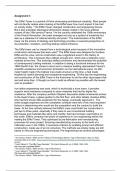Assignment 3
The Eiffel Tower is a symbol of Paris showcasing architectural creativity. Most people
will not directly realize when looking at the Eiffel tower how much impact it has had
on society today.1 The Eiffel Tower changed construction and engineering forever.
But it also embodies ideological dimensions deeply rooted in the socio-political
context of late 19th-century France.2 As the country celebrated the 100th anniversary
of the French Revolution, the tower emerged not only as a symbol of modernity but
also as a statement of national identity and pride.3 The historicization of the Eiffel
tower via the prisms of ideology and technology provides a nuanced perspective on
its production, reception, and long-lasting cultural influence.
The Eiffel tower can be viewed from a technological prism because of the innovative
construction techniques that were used.4 The Eiffel tower was designed by Gustave
Eiffel and his crew, and its construction was a significant event in the history of
architecture. This is because they utilized wrought iron, which was a relatively novel
material at the time. This technique defied convention and demonstrated the potential
of contemporary building methods. In addition to being a functional entrance for the
1889 World's Fair, the choice to erect such a massive building represented France's
scientific excellence and economic domination on the international scene. Its 300-
meter height made it the highest man-made structure at the time, a feat made
feasible by careful planning and exceptional engineering. Till this day the engineering
and construction of the Eiffel Tower is the forerunner for all the other skyscrapers that
are built since then. It thought us how to build as efficient as possible with the lowest
cost as possible.5
Iron lattice engineering was used, which is technically a truss tower, it provides
superior wind resistance compared to stone materials that had far higher fire
resistance. After the company architect Stephen Sauvestre added ornamental arches
to the tower's base, a glass pavilion to the first floor, and other details, Gustave Eiffel,
who had first shown little excitement for the design, eventually approved it. The
entire budget expenses and the completion schedule were two of the most important
factors in determining who would win the competition and the contract to build the
tower. At the time nobody believed that Eiffel's crew could finish the construction in
just two to three years, especially if they were to use conventional building
techniques and materials like stone and marble, that had not been used before on
this scale. Eiffel’s company had years of experience in iron engineering before the
making the Eiffel Tower. They optimized its pre-fabrication and manufacturing
processes for every project. Ensuring manufacturing accuracy to the tenth of a
millimeter even in the 1880s, it overcame criticism by enabling prompt and efficient
construction, made use of an iron structure. The methods we employ today are still
based on this pre-engineering techniques. Pre-engineering has several advantages,
1 De Oliveira, Patrick, "Eiffel and the Telling of Technological Stories," Age of Revolutions. May 23, 2022.
Accessed March 22, 2024, https://ageofrevolutions.com/2022/05/23/eiffel-and-the-telling-of-technological-
stories/.
2 Levin, Miriam R, “The Eiffel Tower Revisited,” The French Review 62, no. 6 (1989): 1052–1053,
http://www.jstor.org/stable/394841.
3 De Oliveira, Patrick, "Eiffel and the," Age of Revolutions.
4 Levin, Miriam R, “The Eiffel Tower Revisited,” The French Review 62, no. 6 (1989): 1052–1053,
http://www.jstor.org/stable/394841.
5 De Oliveira, Patrick, "Eiffel and the," Age of Revolutions.





